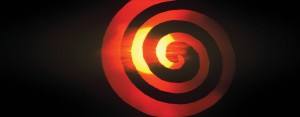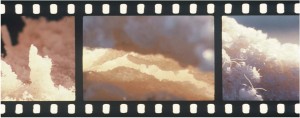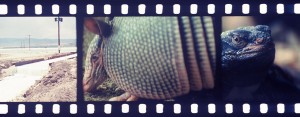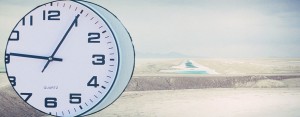It’s Tacita Dean season in Philadelphia. With her six films of Merce Cunningham performing a John Cage piece, STILLNESS, at the Fabric Workshop and Museum and the debut of her new film JG at Arcadia University Art Gallery, the British-born, Berlin-based artist and champion of 16mm filmmaking makes her case for the old school methods in a pithy and beautiful work.

261⁄2 minutes.
JG could be the poster child for the slow film movement, if there was one. The 26 1/2 minute meditation on landscape, time and death and life in the natural world, unfolds like time itself, speeding up or slowing down as the scenes pass before you with little to no narrative thread to speak of. This is not meant as a negative, but I kept comparing the piece to a Lava lamp as I sat there entranced by the beauty, luminescence and seemingly never-ending display of the same things over and over and over.

261⁄2 minutes.
It’s hardly a surprise but the beautiful panning scenes of the great salt flats of California and the Great Salt Lake in Utah, interspersed with loving closeups of salt crystals, foamy, briny water, and some animals — a very cute armadillo — feel a little ike a David Attenborough nature special minus David Attenborough. Like Attenborough, Dean imparts her passion for her subject in every scene. The primordial and post-apocalyptic land and the armadillo get equal star turns (as does an earth-moving machine, which looks for all the world like a robotic dinosaur). They are loved by the filmmaker for their great sensual beauty and mystery. How is it the armadillo came into being? Why do we have salt lakes and salt flats like these? I’m not asking for an answer but I love to mull over the question, as this movie asks you to.

261⁄2 minutes.
Much of the camera work is at dogs-eye level which gives great immediacy to, for example, a scene of water washing over the salt crystals, in which you can almost smell and taste the brine. Ambient sounds reinforce the you are there mood of the piece.
The topic of Dean’s film brings together her hunt in 2009 for Robert Smithson’s Spiral Jetty (the piece was submerged and she didn’t find it), and her love of the British writer J.G. Ballard‘s story The Voices of TIme, which ends in an apocalyptic scenario that revolves around a spiral. Of course JG is more than that. Dean may have set off to find Smithson’s Spiral, but along the way she got entranced with Ballard’s mysticism and the spiraling symbols themselves, which embody ideas of the labyrinth, life and the infinite.

261⁄2 minutes.
The synthesis of Smithson and Ballard in JG works on a subliminal level. If you don’t know about either Smithson or Ballard, what you will come away with is a half hour in which you study the land and think about how small humans are in the infinity of space and time. The movie will also give you a desire to visit the salty landscape, which truly looks like no other place you’ve seen, with its blasted colors, strange light and feel of utter inhospitability.
Dean’s film is noteworthy for its technique. Not only does she use film (a rare, primordial commodity in today’s film world) but she has invented a collage system that allows her to manually superimpose stencil-like masks onto the film, giving a result that is both jarring and Surreal. This collaging of flat imagery like a clock, a spiral and a pair of black film sprockets from a 35-mm camera recurs frequently over the 26 1/2 minutes and provides maybe a little too much reinforcement of the movie’s themes.

261⁄2 minutes.
Of the masks, the spiral in particular appeals to me the way it is drawn — in a cartoon way that — to me at least — evokes Dr. Seuss. I am probably the only person to make the association, but when an artist provides you with the opportunity to let your mind free-associate, the results are often surprising — and apt. I could see a Dr. Seuss treatment of the metaphysical subject of time.
A little like a visit to Mark Rothko’s chapel, a visit to Arcadia’s gallery, which is decked out as a black box theater for this movie premiere, will reward you with a half hour’s grace and beauty and the time, if you let yourself, to relax and meditate on the greater world,or whatever free associations circle round. By the way, the film is meant to loop endlessly, and viewers are meant to drop in whenever and stay however long.
Two books accompany the film, an artist’s book, Key Stroke, a collaboration between Dean (photographs taken with JG Ballard’s camera) and Will Self (writer who wrote a manuscript typed on JG Ballard’s typewriter); and a catalog with images from the film and short writings by Dean, Arcadia Gallery Driector Richard Torchia, Jeremy Millar and others. JG was funded in part by the Pew Center for Arts & Heritage. More information about the film at their website.
————————–
At the press opening for JG Tacita Dean spoke about her film and filmmaking.
She thinks it’s a tragedy that film is being replaced by digital media. As an example of what film provides that digital media doesn’t she talked about flaws in the film process. “Film flaws can be beautiful but digital flaws can’t.”
Digital filmmaking is flabby, she said, theres too much choice. But she mentioned that she does use digital sound.
About JG she said “This film is about film time, geological time…and about the spiral. It’s not the only subject. This film has many subjects. It’s about the medium of film as much as the Spiral and J.G.”
Talking about the dying film industry, she said there are very few 35 mm projectors and only a handful of theaters that use them. “This is film’s apocalypse right now,” she said.
She believes film will come back but that people won’t know how to use it
JG, a new film by Tacita Dean, through April 21, 2013. Arcadia University Art Gallery. Glenside, PA.
Merce Cunningham Performs Stillness (six performances, six films), through Mar. 17, 2013. Fabric Workshop and Museum, 1214 Arch St.









